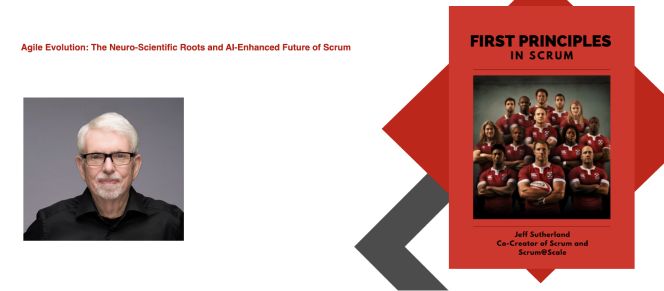Estimating Sprint Planning with AI: Enhancing Agile Practices In the dynamic realm of Agile, effective sprint planning is crucial for delivering high-quality products efficiently. Integrating Artificial Intelligence (AI) into sprint planning can revolutionize estimation accuracy, enhancing the Scrum framework’s adaptability and productivity. This blog post explores the foundational elements of Scrum, the role of sprint planning, and how AI can optimize this process while maintaining the core principles of team autonomy and empirical process control. Understanding Scrum: The 3-5-3 Framework Scrum, a robust framework for managing and completing complex projects, operates on a 3-5-3 structure: These components create an empirical process, enabling teams to inspect and adapt their practices continuously. The Essentials of Sprint Planning Sprint Planning is a critical event in Scrum, where the team collaborates to define what can be delivered in the upcoming sprint and how that work will be achieved. This involves: Effective sprint planning ensures alignment, focus, and a shared understanding of the work ahead. The Role of AI in Sprint Planning Integrating AI into sprint planning can significantly enhance estimation accuracy and resource allocation while respecting Scrum’s principles. Here’s how AI can transform sprint planning: Implementing AI-Enhanced Sprint Planning To effectively integrate AI into sprint planning, teams should consider the following steps: Conclusion Incorporating AI into sprint planning offers a strategic advantage, enabling more accurate estimations, better resource management, and proactive risk mitigation. By embracing AI as a supportive tool, Agile teams can enhance their productivity and adapt more swiftly to changing project dynamics, ultimately delivering higher value to customers. The synergy between humans, AI, and the Scrum framework can drive remarkable improvements in performance and innovation. Stay ahead in the Agile landscape by integrating AI into your sprint planning process, ensuring your team is equipped to deliver twice the work in half the time. For those unfamiliar with the nuances of Scrum, it’s advised to read “Scrum: The Art of Doing Twice the Work in Half the Time” by Jeff and JJ Sutherland. And for those seeking deeper insights, consider exploring “First Principles in Scrum.”
Tag Archives: AI
AI Scrum Planning: Streamline Your Sprints
AI Scrum Planning: Streamline Your Sprints In the fast-paced world of project management, Scrum has established itself as a transformative framework for facilitating agility and efficiency. At JVS Management, integrating Artificial Intelligence (AI) into AI Scrum Planning is taking efficiency to unprecedented levels. We’ve harnessed the power of AI to enhance decision-making, optimize resource allocation, and refine estimation processes, drastically reducing our sprint estimation time from 45 minutes to a mere minute. Training AI for Scrum Excellence The foundation of our approach begins with the meticulous training of AI tools like ChatGPT, grounded in seminal Scrum principles as outlined in Jeff Sutherland’s “Scrum: The Art of Doing Twice the Work in Half the Time”. This preparatory step ensures that our AI models are well-versed in Scrum methodologies, enabling them to provide valuable insights and predictions. Data Analysis for Prioritization Utilizing AI algorithms, we analyze an array of data sources including historical project data, user feedback, market trends, and business priorities. This comprehensive analysis aids our product owners in effectively prioritizing backlog items. For instance, the AI examines data from the last six sprints to inform story point estimations for upcoming tasks, streamlining the prioritization process. AI-Powered Estimation and Forecasting AI-powered tools are employed to scrutinize historical data on team velocity and task complexity, among other factors, to generate accurate sprint forecasts. By training ChatGPT with data from previous sprints, the tool is capable of providing estimated story points for new sprint tasks within an astonishingly short time frame. Intelligent Resource Allocation Through AI algorithms, tasks are allocated to team members based on their skills, availability, and workload capacity. This not only ensures a balanced distribution of work but also enhances overall team performance and project delivery. Dependency Analysis with AI Our teams utilize AI-powered tools for a thorough dependency analysis, which aids in identifying and visualizing dependencies between backlog items. This step is critical for planning and managing interdependent tasks effectively, ensuring a smooth workflow throughout the sprint. Proactive Risk Management AI also plays a crucial role in identifying potential risks and issues early in the planning process. By evaluating AI-generated estimates against team capacity and historical performance, we can anticipate and address potential bottlenecks or constraints before they impact the sprint. Scenario Planning for Flexibility AI-driven simulation tools allow us to generate various planning scenarios based on different assumptions and constraints. This capability enables our teams to explore alternative planning strategies and make informed decisions that align with project goals and resources. Embracing Continuous Improvement Lastly, AI provides ongoing insights and recommendations for process improvements based on data analysis and performance metrics. This not only helps in refining our planning practices but also ensures that our methodologies evolve in response to changing project dynamics. Integrating AI into Scrum planning has significantly enhanced our capabilities at JVS Management, providing us with data-driven insights, automating repetitive tasks, and facilitating more accurate forecasting and decision-making. By leveraging advanced AI technologies, our teams have been able to streamline their planning processes, improve collaboration, and deliver higher-quality products more efficiently. This AI-driven approach to Scrum is not just about maintaining pace with technological advancements but about setting new standards in project management efficiency. Explore more about how AI can revolutionize your project management practices by contact us directly though JVS Management contact form. Join us in transforming the landscape of Scrum planning and project delivery through innovative technology solutions.
Unveiling the Future of Agility: Neuroscience and AI Enhance Scrum Practices
Unveiling the Future of Agility: Neuroscience and AI Enhance Scrum Practices In the rapidly evolving world of Agile development, the journey from a Swiss meetup to an upcoming Australian conference showcases how Dr. Jeff Sutherland’s pioneering work continues to shape the future of business agility across the globe. As the co-creator of Scrum and a signatory of the Agile Manifesto, Dr. Sutherland bridges agile methodologies with the latest in neuroscience and artificial intelligence, offering organizations a forward-thinking framework to thrive amidst change. A Foundation in Universal Science During his Swiss presentation, Dr. Sutherland unveiled the deep-rooted connection between the Scrum framework and the immutable laws governing our universe—from physics to biology. His insights emphasized Scrum’s broad applicability, extending far beyond traditional product development. At the heart of his upcoming Australian meetup, Dr. Sutherland will further explore how Scrum’s agile practices mirror the natural world’s principles, such as those found in Wolfram’s Physics Project and Friston’s Free Energy Principle. This integration positions Scrum as an innate system for managing complex adaptive environments, reflecting the empirical processes intrinsic to both Scrum and evolutionary dynamics. Empowering Agile Teams with AI A central theme of Dr. Sutherland’s discourse, both in Switzerland and anticipated in Australia, is the transformative role of AI within Agile teams. Contrary to concerns about AI overshadowing human capabilities, Dr. Sutherland illustrates AI’s potential to enhance human creativity and collaboration. Through examples and theoretical exploration, he champions AI as a catalyst for empowering teams, driving innovation, and elevating productivity within the Scrum framework. Charting a Course to Hyper-Productivity Dr. Sutherland’s TEHS Scrum Framework—aiming for “Twice the Energy with Half the Stress”—showcases the application of physics and neuroscience principles to foster empowered, innovative teams. Success stories from industry leaders like Rocket Mortgage and John Deere highlight the potential of agile methodologies enriched by scientific understanding and AI advancements. These narratives underscore a shift towards more adaptive, resilient, and high-performing organizational cultures. Global Implications and Opportunities The convergence of neuroscience and AI with Scrum practices heralds unprecedented opportunities for innovation and growth on a global scale. As Dr. Sutherland prepares to share his knowledge in Australia, following his Swiss presentation, organizations worldwide are encouraged to explore these principles and their applicability to their operations. The promise of an enhanced Scrum framework, underpinned by the latest scientific and technological advances, points the way to unparalleled agility and productivity. Join the Global Agile Revolution As we navigate the digital age’s complexities, Dr. Sutherland’s insights offer a beacon for organizations worldwide. By embracing Scrum’s neuro-scientific foundations and integrating AI, businesses can unlock new levels of performance and innovation. As the agile revolution unfolds from Switzerland to Australia and beyond, we’re invited to redefine collaboration and work. Dive into the transformative concepts discussed by Dr. Sutherland, which have resonated from Switzerland and will soon inspire audiences in Australia. Begin a journey of discovery and empowerment, revolutionizing your agility and productivity approach. Access Dr. Jeff Sutherland’s Presentation Slides Here. For those unfamiliar with the nuances of Scrum, it’s advised to read “Scrum: The Art of Doing Twice the Work in Half the Time” by Jeff and JJ Sutherland. And for those seeking deeper insights, consider exploring “First Principles in Scrum.”
The Symbiotic Relationship between AI and Scrum: The Future of Agile in an AI-Driven World
The Symbiotic Relationship between AI and Scrum: The Future of Agile in an AI-Driven World With the rapid advancements in artificial intelligence (AI) and the ongoing momentum of the Scrum framework, the integration of the two is not merely an innovation—it’s a revolution. Dr. Jeff Sutherland, a visionary in the realm of Agile and Scrum methodologies, presents a comprehensive perspective on the future of Scrum in the age of AI. Agile Evolution and the AI Seed of Change At the heart of Agile lies the principle of continuous evolution and adaptation. Much like the oak tree that springs from a single seed, the foundational principles of Scrum and AI are transformative by nature. Just as the oak tree grows, expands, and strengthens, AI is set to magnify team productivity, offering potential 5x and even 25x multipliers. Yet, this isn’t merely about AI taking center stage—it’s about its symbiotic relationship with Scrum. As Dr. Sutherland aptly puts it, “AI won’t take your job. Someone using AI will!” AI as a Catalyst for Agile Transformation While the universe and its intrinsic complexities remain unpredictable, our predictive capabilities are being enhanced dramatically with AI. Agile principles emphasize the need to inspect, adapt, and respond to change. AI acts as a torchbearer in this journey, illuminating the path with data-driven insights, predictive analytics, and adaptive learning. The convergence of these two powerhouses—Scrum and AI—presents a transformative potential: Scrum Collaboration Enhancement: AI can refine team communications, refine backlogs, and guide meetings. Continuous Learning & Improvement: AI analyzes team dynamics, identifies bottlenecks, and suggests pivotal enhancements. Customized Scrum Training: AI provides individualized training materials and simulations, making the adoption of Scrum principles more intuitive and effective. The Power of AI in Scrum Ceremonies One of the most compelling shifts we’re witnessing is the integration of AI into Scrum ceremonies. AI isn’t just a tool—it’s becoming an integral member of Scrum teams. Daily Stand-ups: AI offers insights on individual progress and potential blockers. Sprint Planning and Review: AI’s analytical prowess can optimize backlog prioritization, streamline reviews, and even guide sprint retrospectives. Furthermore, AI is revolutionizing stakeholder communication, ensuring that feedback loops are more effective, and decisions are well-informed. Remote Work and AI: In a world where remote work is becoming the norm, AI’s capabilities, particularly with tools like ChatGPT-4, can transcribe, summarize, and analyze meetings, bridging communication gaps, and ensuring seamless collaboration across borders. Scaling and Streamlining with AI: As organizations scale, AI offers tremendous potential. From facilitating cross-team communication and dependency management to refining product backlogs for numerous teams, AI is becoming the heart and soul of scalable Scrum frameworks. Securing the Future with AI: As AI integration accelerates, there’s a paramount need for ensuring security and privacy. Regular security assessments, encryption, and stringent access control are essential to safeguard data and maintain trust. AI & Scrum—A Future Built on Collaboration Dr. Sutherland’s insights provide a roadmap for the future of Agile in the AI era. As he says, “Training AI is Like Bringing up a Child”—it’s vital to inculcate the right values, maintain transparency, and strive for mutual growth. While the potential is immense, it’s also essential to approach AI with caution, ethics, and responsibility. As we stand on the precipice of an AI-Scrum convergence, the message is clear: Embrace AI, but always remember the human-centric values at the heart of Scrum. The future awaits, and it’s one of co-pilot collaboration, not terminators. For those unfamiliar with the nuances of Scrum, it’s advised to read “Scrum: The Art of Doing Twice the Work in Half the Time” by Jeff and JJ Sutherland. And for those seeking deeper insights, consider exploring “First Principles in Scrum.”




